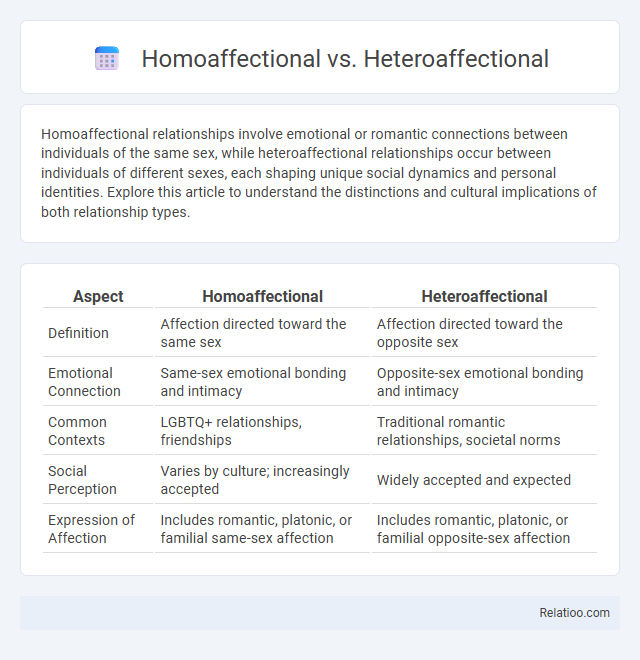Homoaffectional relationships involve emotional or romantic connections between individuals of the same sex, while heteroaffectional relationships occur between individuals of different sexes, each shaping unique social dynamics and personal identities. Explore this article to understand the distinctions and cultural implications of both relationship types.
Table of Comparison
| Aspect | Homoaffectional | Heteroaffectional |
|---|---|---|
| Definition | Affection directed toward the same sex | Affection directed toward the opposite sex |
| Emotional Connection | Same-sex emotional bonding and intimacy | Opposite-sex emotional bonding and intimacy |
| Common Contexts | LGBTQ+ relationships, friendships | Traditional romantic relationships, societal norms |
| Social Perception | Varies by culture; increasingly accepted | Widely accepted and expected |
| Expression of Affection | Includes romantic, platonic, or familial same-sex affection | Includes romantic, platonic, or familial opposite-sex affection |
Understanding Homoaffectional and Heteroaffectional Terms
Understanding the terms homoaffectional and heteroaffectional helps clarify the nuances of emotional and romantic attractions beyond just sexual orientation. Homoaffectional refers to affectionate feelings and bonds between individuals of the same gender, often emphasizing emotional intimacy without necessarily involving sexual attraction. Recognizing the distinction between these terms and orientation can enhance your comprehension of diverse human relationships and the variety of ways people experience affection.
Historical Context of Homoaffectional and Heteroaffectional Relationships
Homoaffectional and heteroaffectional relationships historically refer to emotional and affectionate bonds between individuals of the same or different sexes, distinct from modern understandings of sexual orientation. In ancient societies, such as Classical Greece and Rome, homoaffectional relationships were socially recognized and expressed through mentorship or companionship, often separate from heterosexual marriage structures. Understanding these historical contexts allows you to appreciate how emotional and social dynamics differed from contemporary concepts of orientation, emphasizing affection and social roles over sexual identity.
Key Differences Between Homoaffectional and Heteroaffectional Orientations
Homoaffectional orientation refers to romantic or emotional attraction primarily toward individuals of the same sex, while heteroaffectional orientation involves attraction to individuals of the opposite sex. The key differences between homoaffectional and heteroaffectional orientations lie in the gender of the partners to whom emotional bonds and affections are directed. Understanding your orientation helps clarify your emotional and romantic preferences without conflating it with sexual behavior or identity labels.
The Importance of Language in Sexual and Romantic Identity
Understanding the distinctions between homoaffectional, heteroaffectional, and orientation is vital for accurately expressing your sexual and romantic identity. Homoaffectional specifically refers to affection toward the same sex without implying sexual attraction, while heteroaffectional describes affection toward the opposite sex, separate from orientation, which encompasses sexual attraction patterns. Precise language in these terms enhances self-awareness and fosters respectful communication in discussions about identity.
Common Misconceptions About Homoaffectional and Heteroaffectional Labels
Common misconceptions about homoaffectional and heteroaffectional labels often confuse these terms with sexual orientation, though they specifically describe the direction of affectionate behavior rather than attraction or identity. You might mistakenly assume that homoaffectional refers to sexual preference when it actually denotes affectionate feelings toward the same gender, while heteroaffectional indicates affectionate feelings toward a different gender. Clarifying these distinctions helps avoid inaccurate assumptions about identity and emotional expression within LGBTQ+ discourse.
Psychological Perspectives on Homoaffectional and Heteroaffectional Bonds
Homoaffectional and heteroaffectional bonds differ primarily in the gender orientation of emotional and romantic attachments, influencing psychological dynamics within intimate relationships. Psychological perspectives emphasize the impact of societal norms and internalized attitudes on the formation and experience of these bonds, affecting identity development and emotional well-being. Studies highlight that homoaffectional relationships often face unique stressors such as stigma and minority stress, which shape coping mechanisms and resilience differently compared to heteroaffectional bonds.
Societal Impacts of Recognizing Diverse Affectional Orientations
Recognizing homoaffectional, heteroaffectional, and other orientation spectrums promotes inclusivity and reduces discrimination by validating diverse emotional and romantic connections. Societal acceptance of varied affectional orientations supports mental health, fosters equality, and enhances legal protections for marginalized communities. These acknowledgments contribute to dismantling heteronormative biases, enabling more equitable social policies and cultural representations.
Representation in Media: Homoaffectional vs Heteroaffectional Narratives
Homoaffectional narratives in media often focus on emotional and romantic bonds between same-gender characters, emphasizing identity and community representation, while heteroaffectional narratives typically portray traditional male-female relationships reflecting societal norms. Representation of homoaffectional stories has historically been limited or stereotyped, but growing visibility fosters greater inclusivity and challenges heteronormative tropes. Orientation, referring to an individual's pattern of romantic or sexual attraction, underpins these narratives and influences how characters and relationships are depicted across diverse media platforms.
Navigating Relationships: Challenges and Opportunities
Homoaffectional and heteroaffectional orientations denote emotional and romantic attractions toward the same or opposite genders, respectively, influencing relationship dynamics and social experiences. Navigating relationships involves understanding the unique challenges such as societal acceptance, identity validation, and communication differences specific to each orientation. Opportunities arise in fostering empathy, self-awareness, and inclusive support networks that enhance relationship quality and resilience across diverse orientations.
Promoting Inclusivity Through Accurate Terminology
Promoting inclusivity through accurate terminology requires understanding distinctions such as Homoaffectional, Heteroaffectional, and Orientation, which refer to emotional and romantic attractions rather than sexual behavior alone. Homoaffectional describes same-gender emotional bonds, Heteroaffectional refers to cross-gender emotional connections, and Orientation encompasses the broader spectrum of sexual, romantic, and emotional preferences. Using precise language respectsYour experiences and fosters a culture of acceptance and understanding across diverse identities.

Infographic: Homoaffectional vs Heteroaffectional
 relatioo.com
relatioo.com